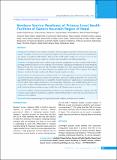Please use this identifier to cite or link to this item:
https://hdl.handle.net/20.500.14356/1342| Title: | Newborn Service Readiness of Primary Level Health Facilities of Eastern Mountain Region of Nepal |
| Citation: | Thapa PachyaA., PachyaU., GiriM., ShakyaS., MahotraA., & ChoulagaiB. P. (2020). Newborn Service Readiness of Primary Level Health Facilities of Eastern Mountain Region of Nepal. Journal of Nepal Health Research Council, 17(4), 431-436. https://doi.org/10.33314/jnhrc.v17i4.2119 |
| Issue Date: | 2019 |
| Publisher: | Nepal Health Research Council |
| Article Type: | Original Article |
| Keywords: | Eastern mountain region of Nepal Health facility readiness Newborn service readiness |
| Series/Report no.: | Oct-Dec, 2019;2119 |
| Abstract: | Abstract Background: Newborn service readiness is facility’s observed capacity to provide newborn services and a pre-requisite for quality. Newborn services are priority program of government and efforts are focused on infrastructure and supplies at peripheral health facilities. Study describes health facility readiness for newborn services in four domains of general requirements, equipment, medicines and commodities, and staffing and guidelines. Methods: Convergent parallel mixed method using concurrent triangulation was done in public health facilities providing institutional deliveries of two randomly selected districts- Taplejung and Solukhumbu of Eastern Mountain Region of Nepal. Face to face interview and observation of facilities were done using structured questionnaire and checklist; in-depth interviews were done using interview guideline from November 2016 to January 2017. Ethical clearance was taken. Descriptive analysis and deductive thematic analysis were done. Results: Mean score of newborn service readiness was 68.7±7.1 with range from 53.3 to 81.4 out of 100. Domains of general requirement, equipment, medicine and commodity, supervision, staffing and guideline were assessed. The gaps identified in general requirements were availability of uninterrupted power supply, means of communication and referral vehicle. Clean wrappers and heater for room temperature maintenance were identified during interviews to be part of the readiness. All health facilities had trained staff while retention of skill was of concern. There was felt need of enforcing adequate training coverage to suffice the need of human resources in remote. Conclusions: Efforts of improving transportation, heater for room temperature maintenance, trainings with skill retention strategy, utilization of guidelines, availability of skilled birth attendance could result increased and improved newborn service readiness. Keywords: Eastern mountain region of Nepal; health facility readiness; newborn service readiness. |
| Description: | Original Article |
| URI: | http://103.69.126.140:8080/handle/20.500.14356/1342 |
| ISSN: | Print ISSN: 1727-5482; Online ISSN: 1999-6217 |
| Appears in Collections: | Vol. 17 No. 4 Issue 45 Oct-Dec 2019 |
Files in This Item:
| File | Description | Size | Format | |
|---|---|---|---|---|
| 2119-Manuscript-13224-1-10-20200121.pdf | Fulltext Download | 555.08 kB | Adobe PDF |  View/Open |
Items in DSpace are protected by copyright, with all rights reserved, unless otherwise indicated.
